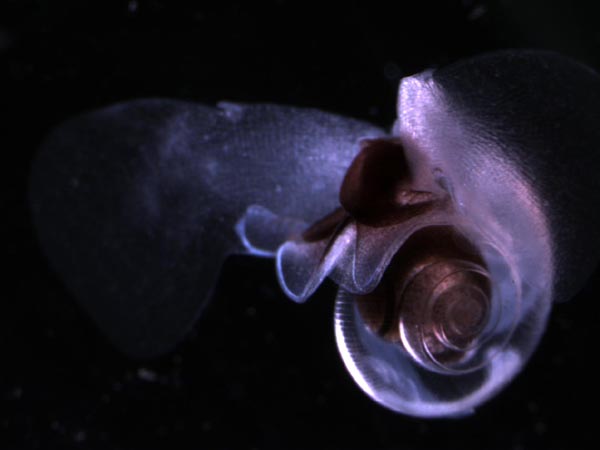Invisible threat to marine life
Increased carbon dioxide in the atmosphere also ends up in the ocean.
A glass of water sitting on a table will absorb carbon dioxide (CO₂) from the air. The CO₂ dissolves, creating a weak solution of carbonic acid—this makes the water more acidic. So, does this happen with the ocean? Does it absorb CO₂ from the atmosphere? It sure does.
The ocean is naturally alkaline, usually with a pH of around 8.2 (a neutral substance has a pH of 7). As the ocean absorbs CO₂, carbonic acid (H₂CO₃) is formed. This releases hydrogen ions (H⁺) which makes the ocean become more acidic. Scientists estimate that the absorption of some of the additional CO₂ in the atmosphere has already lowered oceanic pH by around 0.1 since 1750, bringing it to 8.1.
The ocean will continue to absorb the extra CO₂ in the atmosphere and under current projections oceanic pH will reach 7.7 by the end of this century, a decline of 0.5. This doesn’t sound like all that much, but the pH scale is logarithmic, so what looks like small changes in pH represents large changes in the concentration of hydrogen ions. The change in pH of 0.1 pH units since 1750 translates into an increase in hydrogen ions of around 26 per cent.
What do acidic substances do? They dissolve stuff. And acid is pretty good at dissolving calcium carbonate—the stuff a huge range of sea creatures use to build their shells or skeletons. So this is a serious problem for a huge range of sea creatures, from corals to crustaceans to shellfish to pteropods—a graceful creature sometimes known as a ‘sea butterfly’.

But the underlying chemistry isn’t quite as simple as ‘acid ocean water dissolves shells’. Even more of a problem is that a more acidic ocean also means that it’s harder for these creatures to build their shells and skeletons in the first place. To build their shells and skeletons, they use calcium (Ca²⁺) and carbonate (CO₃²⁻) from the ocean. The amount of available carbonate is called the carbonate ‘saturation state’ and it varies in different regions of the ocean. In a more acidic ocean, the extra hydrogen ions floating around mean that instead of carbonate (CO₃²⁻), bicarbonate (HCO₃⁻) is more likely to form. This means there’s less carbonate—the carbonate saturation state is lower. There are fewer carbonate ions available for these ocean dwellers to build their shells and skeletons.
What’s more, calcium carbonate occurs in two forms—calcite and aragonite. These have the same chemical composition, but the atoms are arranged in a different structure, and have different stabilities. Aragonite is less stable than calcite, which means that it not only dissolves more readily, but its formation also requires a higher carbonate saturation state. This means that the critters that use aragonite for their shells and skeletons—some types of coral, and some shellfish—will be in even more trouble in a more acidic ocean.
The acidification of the ocean is not a short-term phenomenon; the oceans have a huge capacity to absorb more CO₂ and they will continue to do so. Over a thousand-year timescale, around 80 per cent of human-produced CO₂ emissions will end up in the oceans. The reversal of this process will only occur as the chemical weathering of rocks neutralises the acidity in the ocean, another process that will take tens of thousands of years.





